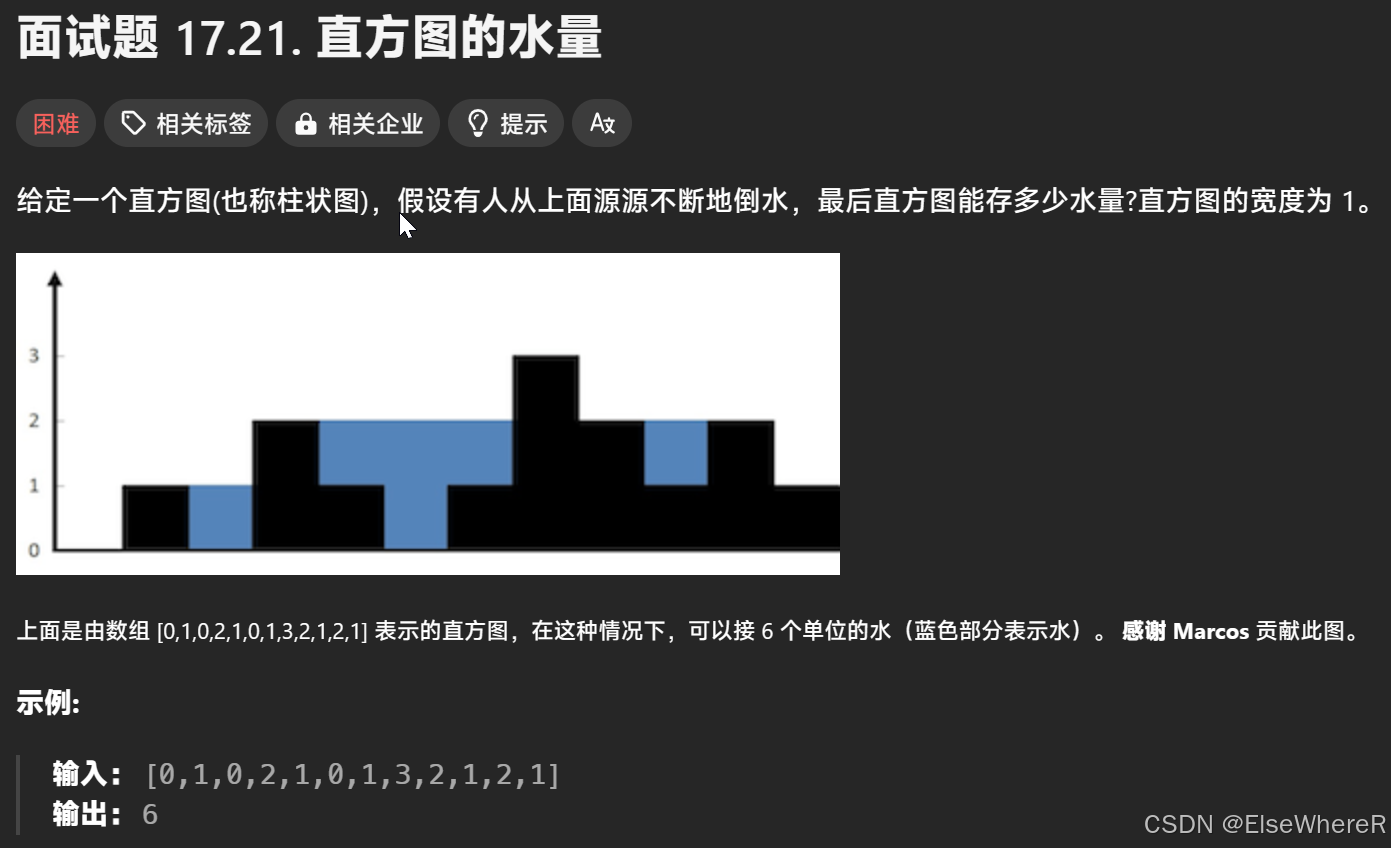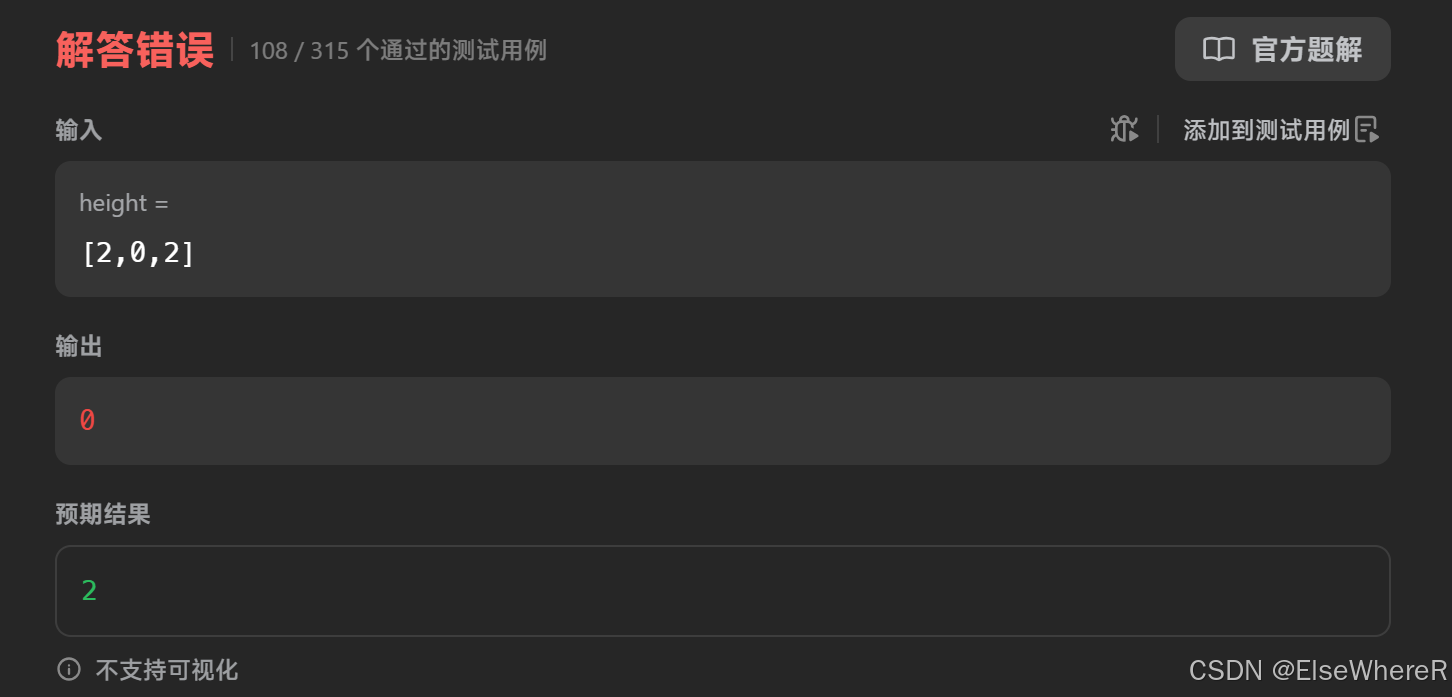*************
C++
topic:面试题 17.21. 直方图的水量 - 力扣(LeetCode)
***********
直接看题:

这个一定是要用到指针的,因为需要比较指针两端的最大高度和中间的差值,这样才能判断中间是不是能存水。
暴力美学,the aesthetics of violence,没有思路的时候,就直接手搓代码,帮助我理清思绪。这个题是真的有点难度的,我想了很长时间都没有思绪。
先想一下怎么存水,如果一个柱子两边的柱子都比它高,那么它就可以存水,存水量等于两边柱子中较矮的那个柱子的高度减去当前柱子的高度,这个是算法的核心,当然这个很好理解。对于每一个位置i,如果它的左边最高的柱子和右边最高的柱子都比它高,那么这个位置可以存水,存水量等于min(左边最高,右边最高) - height[i]。因此,初步解决方案:对于每个位置i,找到它左边的最高柱子和右边的最高柱子,然后计算min(left_max, right_max) - height[i],累加所有这样的值,就是总的存水量。
首先回想一下,我之前做过的题目,有没有相关的,类似的题目,子序列不是的,哈希表也不像,因为不需要查找不一样的元素,这个题目的里面是可以包含一样的。
没有思绪,上 暴力美学,永远可以相信暴力美学:
| .size | 0 | 1 | 2 | 3 | 4 | 5 | 6 | 7 | 8 | 9 | 10 | 11 |
| s | 0 | 1 | 0 | 2 | 1 | 0 | 1 | 3 | 2 | 1 | 2 | 1 |
1. 初始化一个变量total_water来存储总的存水量,初始值为0。
2. 遍历数组中的每一个位置i:
a. 找到i左边最高的柱子left_max。
b. 找到i右边最高的柱子right_max。
c. 计算当前存水量current_water = min(left_max, right_max) - height[i]。
d. 如果current_water > 0,将current_water加到total_water中。
3. 返回total_water。
OK,看起来可行,直接写代码:
首先完成第一步:
class Solution {
public:
int trap(vector<int>& height) {
int total_water = 0; // Step 1: Initialize total_water
int n = height.size();
if (n == 0) return 0;
vector<int> left_max(n, 0); // initialise the max heught equals 0
vector<int> right_max(n, 0); // so is the right one
}
};这里有个小细节,就是
vector<int> left_max(n, 0); // initialise the max heught equals 0
vector<int> right_max(n, 0); // so is the right one
初始化成为向量,这样就可以直接用 left_max[i]表示 i 位置的左边的最高值。
然后找到当前位置的左侧的最大值和右侧的最大值:
class Solution {
public:
int trap(vector<int>& height) {
int total_water = 0; // Step 1: Initialize total_water
int n = height.size();
if (n == 0) return 0;
vector<int> left_max(n, 0);
vector<int> right_max(n, 0);
// find max
for (int i = 1; i < n; ++i) {
left_max[i] = max(left_max[i - 1], height[i]);
}
for (int i = n - 2; i >= 0; --i) {
right_max[i] = max(right_max[i + 1], height[i]);
}
}
};遍历所有位置,并求个和:
class Solution {
public:
int trap(vector<int>& height) {
int total_water = 0; // Step 1: Initialize total_water
int n = height.size();
if (n == 0) return 0;
vector<int> left_max(n, 0);
vector<int> right_max(n, 0);
// find max
for (int i = 1; i < n; ++i) {
left_max[i] = max(left_max[i - 1], height[i]);
}
for (int i = n - 2; i >= 0; --i) {
right_max[i] = max(right_max[i + 1], height[i]);
}
// go through every position
for (int i = 0; i < n; ++i) {
// caculate current
int current_water = min(left_max[i], right_max[i]) - height[i];
// 如果current_water > 0,将current_water加到total_water中
if (current_water > 0) {
total_water += current_water;
}
}
return total_water;
}
};不出意外的,又错了

这个答案一看就是2,为什么算出来是0呢?
按照代码跑一遍:
n = 3
i = 1
left_max[0] = max(left_max[0], height[1],
问题吹在了这里,没有left_max[0]
初始化left_max[0] = height[0].
class Solution {
public:
int trap(vector<int>& height) {
int total_water = 0; // Step 1: Initialize total_water
int n = height.size();
if (n == 0) return 0;
vector<int> left_max(n, 0);
vector<int> right_max(n, 0);
// find max
left_max[0] = height[0];
for (int i = 1; i < n; ++i) {
left_max[i] = max(left_max[i - 1], height[i]);
}
right_max[n - 1] = height[n - 1];
for (int i = n - 2; i >= 0; --i) {
right_max[i] = max(right_max[i + 1], height[i]);
}
// go through every position
for (int i = 0; i < n; ++i) {
// caculate current
int current_water = min(left_max[i], right_max[i]) - height[i];
// 如果current_water > 0,将current_water加到total_water中
if (current_water > 0) {
total_water += current_water;
}
}
return total_water;
}
};OK,这个可以run,比较的成功。
动态规划还是好啊。





















 275
275

 被折叠的 条评论
为什么被折叠?
被折叠的 条评论
为什么被折叠?








